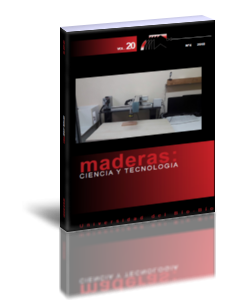Effect of the Brazilian process of thermal modification on the physical properties of Eucalyptus grandis juvenile wood
Keywords:
Equilibrium moisture content, heat treatment, hygroscopicity, swelling, densityAbstract
This study is a continuation of a previous study published in this journal, with the aim of evaluating the effect of the Brazilian industrial thermal modification process on some physical properties of Eucalyptus grandis juvenile wood. Flatsawn boards of juvenile wood were tested for four treatment levels: untreated and thermally modified wood at final cycle temperatures of 140 °C, 160 °C and 180 °C. Physical properties were assessed according to a standard of the Comisión Panamericana de Normas Técnicas and a method proposed by the specialized literature encompassing equilibrium moisture content (a measure of wood’s hygroscopicity), density (oven-dried and air-dried) and radial, tangential and volumetric swelling (from oven-dried to green moisture content). Thermally modified Eucalyptus grandis wood became less hygroscopic, more dimensionally stable (tangential and volumetric swelling) and less dense, even at the lowest temperature tested (140 °C), except for radial swelling, which did not differ from untreated wood.
Downloads
References
Batista et al. 2016. Effect of the Brazilian thermal modification process in the chemical composition of Eucalyptus grandis juvenile wood – part 1: cell wall polymers and extractives contents. Maderas-Cienc Tecnol 18(2): 273-284.
Batista, D.C. et al. 2011. Efeito do tempo e temperatura de modificação térmica na redução do inchamento máximo da madeira de Eucalyptus grandis Hill ex Maiden. Ciência Florestal 21(3): 533-540.
Batista, D.C.; Klitzke, R.J. 2011. Influência do tempo e temperatura de retificação térmica na umidade de equilíbrio da madeira de Eucalyptus grandis Hill ex Maiden. Scientia Forestalis 38(86):255-261.
Cademartori et al. 2012. Modification of static bending strength properties of Eucalyptus grandis heat-treated wood. Materials Research 15(6):922-927.
Cademartori et al. 2013. Thermal modification of Eucalyptus grandis wood: variation of colorimetric parameters. Maderas-Cienc Tecnol 15(1):57-64.
Cademartori et al. 2015. Effect of thermal treatments on technological properties of wood from two Eucalyptus species. Anais da Academia Brasileira de Ciências 87(1):471-481.
Calonego, F.W. et al. 2010. Decay resistance of thermally-modified Eucalyptus grandis wood at 140 °C, 160 °C, 180 °C, 200 °C and 220 °C. Bioresource Technology 101 (23):9391-9394.
Calonego et al. 2012. Physical and mechanical properties of thermally modified wood from E. grandis. European Journal of Wood Products 70:453-460.
Calonego et al. 2013. Tipos de ruptura em madeira de Eucalyptus grandis modificada termicamente. Silva Lusitana, Especial:153-161.
Calonego et al. 2014. Effect of thermal modification on the physical properties of juvenile and mature woods of Eucalyptus grandis. Floresta e Ambiente 21(1):108-113.
Comisión Panamericana de Normas Técnicas. 1972. COPANT 462: Método de determinación de la contracción.
Esteves, B.M.; Pereira, H.M. 2009. Wood modification by heat treatment: a review. BioResources 1(4): 370-404.
Fengel, D.; Wegener, G. 1989. Wood: chemistry, ultrastructure, reactions. Walter De Gruyter, New York.
Finnish Thermowood Association. 2003. ThermoWood® handbook. Finnish Thermowood Association, Helsinki.
Garcia et al. 2012. Nondestructive evaluation of heat-treated Eucalyptus grandis Hill ex Maiden wood using stress wave method. Wood Science and Technology 46:41-52.
Garcia et al. 2014. Modificação da cor original da madeira de Eucalyptus grandis através de tratamentos termorretificadores. Cerne 20(3):449-457.
Hill, C. 2006. Wood modification: chemical, thermal and other processes. John Wiley & Sons, West Sussex.
Lazarotto et al. 2016. Resistência biológica e colorimetria da madeira termorretificada de duas espécies de eucalipto. Árvore 40(1):135-145.
Modes et al. 2013. Hygroscopity of wood from Eucalyptus grandis and Pinus taeda subjected to thermal treatment. Cerne 19(1):19-25.
Perdure. 2011. Research and development: physical properties. PCI Industries, Quebec.
Platowood. 2011. Platowood infosheet: physical and mechanical properties. Platowood BV, Arnhem.
Retiwood. 2011. Research and development: physical properties. Retiwood, Paris.
Ribeiro Júnior, J. I. 2001. Análises estatísticas no SAEG. Universidade Federal de Viçosa, Viçosa.
Skaar, C. 1972. Water in wood. Syracuse University Press, Syracuse.
Spiegel, M.R. 1994. Estatística. 3. ed. Pearson Education do Brasil, São Paulo.
Stamm, A.J. 1964. Wood and cellulose science. The Ronald Press, New York.
Xie, Y. et al. 2002. Heat treated wood and its development. Journal of Forestry Research, 13(3):224-230.
Zanuncio et al. 2014a. Química e colorimetria da madeira de Eucalyptus grandis W.Mill ex Maiden termorretificada. Árvore 38(4):765-770.
Zanuncio et al. 2014b. Termorretificação e colorimetria da madeira de Eucalyptus grandis. Floresta e Ambiente 21(1):85-90.

































